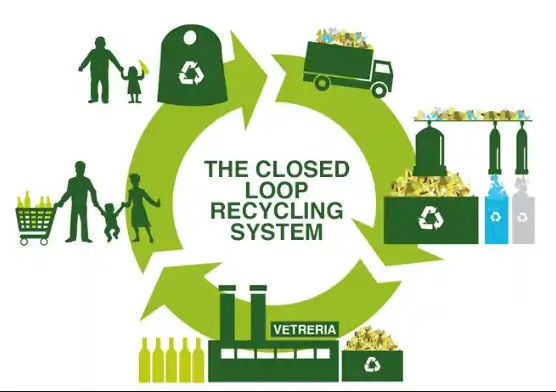Development of Closed-Loop Recycling System
Can fashion be sustainable? | Closed-loop recycling & bio-based methods | Textile industry's sustainability explored
Introduction
The textile industry has been targeted constantly by critics for its massive usage of resources, natural and fossil-derived, as well as the detrimental effects that clothing consumption, production, and dumping have on the environment and society. In this regard, it is the need of the hour to establish a circular economy for textiles intended for recycling ideas and methods to safeguard the earth, its resources, and its inhabitants. Reusing textile fibers through mechanical and chemical processes has been the main emphasis of recycling technologies until this point. Besides life composting, bio-based methods for manufacturing and recycling textiles have gained minimal attention. A novel strategy is needed to create circular and sustainable textile production methods that consider the selection of materials and decorations that can be recycled after their useful lives.
Since non-biological methods like fiber blending, synthetic pigments, and finishes make up the majority of the textiles creation process, the technical cycle has received the most of the attention when discussing the circularity of the fashion industry. The technical cycle is built on nonrenewable petro-based components that can only be salvaged and recycled.
What is closed-loop recycling?
Closed-loop recycling refers to the process in which a material is reprocessed into a more or less similar product.
A circularized fashion industry is described by means of closed-loop processes where the disposed fabrics and their related products are transformed into textiles, for example, through fiber-to-fiber recycling.
The biological cycle depends on substances that can break down and produce nutrients to convert into fresh, renewed resources. The biological cycle relies on natural nutrients like discarded food to renew soil via procedures like composting and oxygen-deprived degradation. Composting is an inefficient utilization of resources for textiles and is inappropriate for a circular economic system that preserves the worth of fabrics. If bio-materials are created that can be composted at the end of their useful lives, the idea is to combine the technological and biological cycles inside the biological cycle. In this sense, microbial methods serve as a transitional technique for material dissemination in the surroundings.
Bio-based processes use enzymes in biochemical reactions and microorganisms in biological transformations to convert feedstock into value-added products. When applied to textiles, these will be specific to each type of fiber and may be adapted from established methods for materials with a similar composition.
Methods for Closed-Loop Mechanical and Chemical Recycling Processes
Mechanical Recycling Processes
The principal mechanical processes for recycling include:
Fiber Recycling
Shredding
Thermo-mechanical recycling
Fiber Recycling
Fiber Recycling typically refers to a mechanical recycling procedure where the fiber is retained while the fabric is disassembled. For all textile products, this procedure is usually employed.
Shredding
Cutting or shredding procedures remain the most popular mechanical recycling technique for processing textile fiber. Hardware components like zips and buttons must be detached before textiles can be shredded into tiny pieces, frequently requiring human assistance. The torn fabric is then used to create a fragment that can be woven into new yarns. One of the drawbacks of mechanical recycling is the shortening of fibers during the shredding phase. Hence, reused and virgin fibers must frequently be blended to produce new yarn with the durability and quality required for clothing. This mechanical recycling technique for cotton fiber recycling in fabric waste has been developed on a massive level. The recycling process for cotton uses a semi-closed loop that incorporates recycled fiber combined with new cotton fiber before being spun into new yarn. When wool is used in textiles, the closed-loop technique is used, which eliminates the requirement to combine virgin fibers. Italian wool manufacturers that work in the Prato region also refer to fiber-to-fiber recycling as regenerated wool.
Thermo-mechanical Recycling
This procedure is also known as heat recycling or mechanical polymer recycling. Synthetic materials must first be melted during thermo-mechanical recycling to be woven again into fresh fibers or molded into alternative shapes. For purely synthetic fibers like polyamide, elastane, thermoplastic polyurethane, and nylon, thermo-mechanical recycling is utilized. Unfortunately, the qualities of re-spun elastane fibers show breaking unless they are turned into solid shapes like bars.
Chemical Recycling Processes
Chemical techniques include:
Monomer recycling
Polymer recycling
De- and Re- polymerization
Fiber blend separation: switchable Hydrophilicity solvent
Fiber blend separation
The polymer chain is frequently degraded by conventional chemical procedures for polymer recycling, resulting in a loss of quality in the regenerated fiber. Monomer recycling converts waste materials into the fiber of pristine quality. Currently, monomer recycling is the only technology being used for synthetic fiber.
Conclusion
Despite all the possible techniques, the sustainability of processes must also be considered. This article aims to show the possibility of a heterogeneous recycling method where fashion industry products would be regenerative, i.e., textile fibers would have the capacity to be regenerated into novel virgin-quality material rather than being down-cycled into lower-grade items.
References
Ellen MacArthur Foundation, A new textiles economy: Redesigning fashion's future (2017)
Sandin, G.M. Peters, Environmental impact of textile reuse and recycling – a review; J. Clean. Prod., 184 (2018), pp. 353-365
Biomimicry Institute, The nature of fashion: moving towards a regenerative system (2020)
K.M. Yu, H. Chen, F. Abeln, H. Auta, J. Fan, V.L. Budarin, J.H. Clark, S. Parsons, C.J. Chuck, S. Zhang, G. Luo, D.C.W. Tsang, Chemicals from lignocellulosic biomass: a critical comparison between biochemical, microwave and thermochemical conversion methods; Crit. Rev. Environ. Sci. Technol., (2020), pp. 1-54
Rittfors, Thermochemical Textile Recycling: Investigation of Pyrolysis and Gasification of Cotton and Polyester, Chalmers University Of Technology, Gothenburg, Sweden (2020)
WRAP, Textile Tagging; Oakdene Hollins Ltd, (2014), Apr 5th 2021
Roos, G. Sandin, G. Peters, S. Bjorn, G.S. Bour, E. Perzon, C. Jonson, White paper on textile recycling; Mistra Future Fashion, Mölndal, Sweden (2019)
Le, Textile Recycling Technologies, Colouring and Finishing Methods. Solid Waste Services; Vancoover, (2018), pp. 23-50




